
Archive for the 'reviews' Category


Kirby & Simon’s Best
June 5th, 2009 Posted by david brothersThe Best of Simon and Kirby
Joe Simon & Jack Kirby, edited by Steve Saffel
240 pages, 9″x12 1/4″
I’m a Kirby fan.
It’s obvious if you know me, I think. I love the Captain America & the Falcon stuff he did, I love the New Gods, and I think that his character design is top notch. Of course, all of my favorite Kirby work was created after he’d become Jack “King” Kirby. This was late era Kirby, if you go by the length of his career.
Early Kirby, the raw stuff from the beginning of his career, is mostly a mystery to me. I have one of Marvel’s Visionaries hardcovers that collects a lot of it, like the Two-Gun Kid stuff, and it’s pretty fascinating. A lot of what made Kirby Kirby was there in the text, though in an unpolished form.
Titan Books recently released The Best of Simon and Kirby, a volume collecting a lot of those issues that I’ve never seen. I’ve got to say that they did a stellar job with it. It’s oversized (essentially a coffee table book), printed on non-glossy paper, and a real work of art. The extra size really lets you get into the art, which is part of the point of this book.
Joe Simon and Jack Kirby were a team for years, and worked in a variety of genres. This volume collects stories featuring superheroes, criminals, and (the deep, dark secret of Kirby & Simon) stories from the original romance book, Young Romance. I’d known that Kirby had a hand in popularizing romance comics, and it’s nice to finally get a chance to read them.
The Best of Simon and Kirby also reprints a couple of titles from DC and Marvel. Captain America, The Vision (the old one), Sandman, and a Boy Commandos tale wrap up the Big Two work in this book.
I really, really like this book. It’s a historical collection, but the way it’s presented is as more of a conversation piece. Each genre gets a chapter break in the form of a short essay that also doubles as a biography of the careers of each man. It’s conversational in tone, and detailed enough to educate you about a time you rarely hear about. It makes it easy to burn through the book, too, since it provides an easy stopping point for each genre. I spent a couple of days knocking out a series of stories before bed.
The most striking thing about this book, I think, is how un-Kirby a lot of it looks. The thick lines and insane layouts that dominated Kirby’s later work are present in the occasional story here, but most of the work isn’t as undeniably “Kirby” as, say, the Fourth World volumes. My first thought is to say that it was Joe Simon’s inking that makes it look so different, but something I keep forgetting is that a lot of these stories were over twenty years old before Kirby put pen to paper on Fantastic Four #1. Over the course of twenty or thirty years, anyone’s style would, and should, change around a little bit.
The Best of Simon and Kirby is forty bucks, which is a little pricey, but worth every penny to Kirby and Simon fans, or even people interested in comics history.

Marvel’s Non-Battle Pope Comic: Paul II
June 4th, 2009 Posted by guest articleIf you’re not up to speed, read the first part of James Howard’s review here! Unless you want to experience it Star Wars style. That’s cool too!
So Wojytla heads back and joins the official Polish delegation to Rome for Pope John XXIII’s Ecumenical Council, where he makes a speech before the assembly and spends his time soaking up the scene.
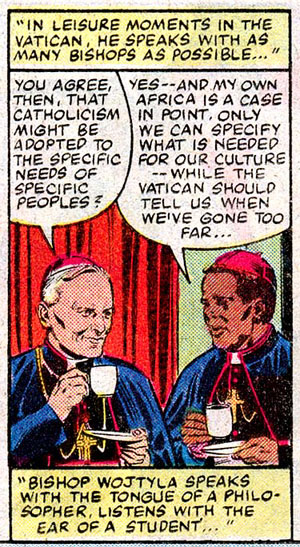
Africa, you know I love you, but stop listening to the fucking Vatican already. And don’t think for a second that the pair are placed next to one another here to imply a sense of colourblind kinship and equality before the Lord; one being a white bishop and one being a black bishop, they’re actually positioned there to spend the evening completely ruining my knights’ mobility.
Wojtyla is officially promoted to Archbishop of Cracow and gains all the perks of the position: new business cards, free jello, and a much, much larger hat.
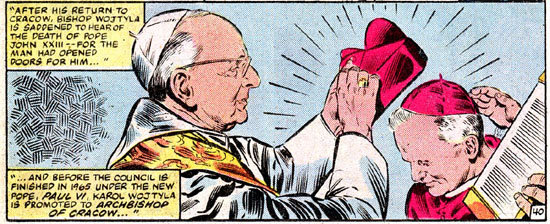
Most people would look at this picture and take most interest in the apparent radioactive properties of the new headwear, but I’m more intrigued by the stubby sausage-like hand sneaking in behind the new Archbishop to swipe his old hat before the new one comes down. What if he wanted to stack them, like Duplo? Is that not allowed?

Marvel’s Non-Battle Pope Comic: Part I
June 3rd, 2009 Posted by guest articleGood evening, gentle readers! My name is James Howard; I like history, and I like comic books, and I am here to talk to you today about both things at the same time.
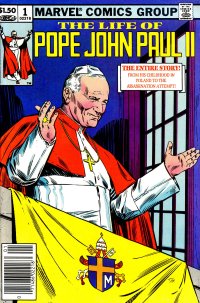
Marvel Comics Presents The Life of Pope John Paul II, 1982 one-shot. Written by Steven Grant, drawn by John Tartaglione, beheld with bewilderment by millions.
This is true: I bought this comic for two dollars, no tax, from the fire sale of a closing Winnipeg comic book store a few years back. I took it home, I read it, and I framed it. Framed it. Because I am a major-league dork.
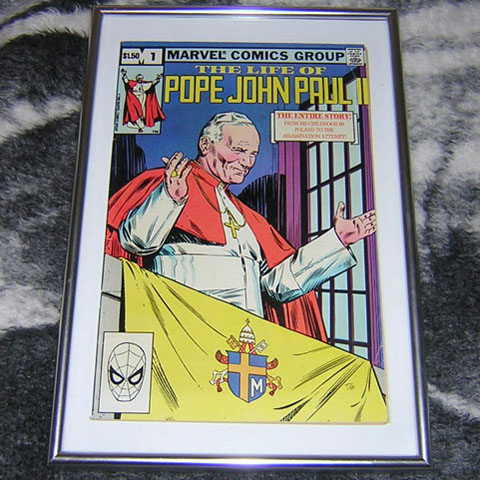
I’m not much for religion, and it’s not an earth-shatteringly great comic (as we’ll get to in a second), but who didn’t have a soft spot for ol’ Pope John Paul II? Dude was like the Catholicism Sara Lee. Passersby and visitors don’t just look at this cover — they stare at it for a few seconds, fishlike and uncomprehending, because honestly what the hell is this.
And given the information you can gleam about it from one glance — comic book, iconic historical figure, single issue — the comic is actually a lot more subdued and grounded than one would originally expect. There’s nothing in here that approaches the funnybook wackiness of Superman punching Muhammad Ali, or Spider-Man using the Socratic Method to foil an exact body double of Barack Obama, or… whatever this was. If they made a comic about the Pope today it would probably be thirty-two pages of Hugh Jackman Wolverine riding a motorcycle through a gunfight in a church in the past, so I guess I’ll take my down-to-earth portrayals where I can get them.

Prince of Persia/Uncharted 2 Contest
June 3rd, 2009 Posted by david brothers
One of my favorite games, from both a story and a gameplay standpoint, is Prince of Persia: Sands of Time. I played through it on either Xbox or PS2, I forget which, but it was a great time. The gameplay combined platforming mechanics and traditional combat to create a kind of gameplay that was extremely fun. The enemies provided a way for the Prince to make his platforming easier, turning creatively acrobatic combat into a crucial gameplay component.
Where the game really shined for me, however, was the story. Shortly before the end of the game, you find out that the game you’ve just played, deaths and all, was not a game– it was a story that the Prince was telling Princess Farah, the daughter of the Maharajah. There are a number of twists involved, but what it boils down to is that, due to an error, the princess died. The Prince reversed time, and now he must convince her of what happened and save her life. So, he told her the story of his adventure.
This wasn’t exactly out of the blue. The Prince narrates the game, and every time you died, he’d say something to the effect of, “No, that’s not how it happened,” and begin again from just before your death. It turned the story of the game into a story within the game, and it’s a plot twist that I greatly appreciated. If anything, it heightened my love for the game and hooked me for life.
First Second Books released a Prince of Persia graphic novel late last year. I picked it up and read it a couple months after release, but never really got around to talking about it on here.
Rather than do a straight adaptation of any of the handful of Prince of Persia titles, writers Jordan Mechner and AB Sina and artists LeUyen Pham, Alex Pulvilland, and Hilary Sycamore instead told a tale that spanned two timelines under the loose umbrella of being about a “prince of Persia.” There is a nice nod early in the novel to the way that the Prince of Persia series has changed over the years. A king calls for his son, the prince, but all three of his children, two sons and a daughter, come together, rather than the prince he wanted. When quizzed about why they all came, they respond, “For I am the prince!”
In a way, I enjoyed Prince of Persia more due to Sands of Time. They both showed a deft way of telling their story in a way that I didn’t expect at the time. The story takes place over two timelines, and they tend to blend in and out of each other as the book goes on. It can be confusing, but not in an off-putting manner. It simply gives the book a different tone than I’d expected. It’s much more whimsical, or fairy tale-like, in tone than a straight up adventure novel. It isn’t quite magical realism. Everything that happens fits within the story and is perfectly believable. However, there is a definite dream-like quality to the story.
Read the rest of this entry �

Pluto: Kids’ Comics for Grownups
May 29th, 2009 Posted by david brothersIn a just world, Pluto: Urasawa x Tezuka would be a game changer.
For the past twenty or thirty years, Marvel and DC have made a business out of telling mature stories with characters that were originally aimed at kids. While they have had some runaway successes, the majority of their output has been less than quality. The characters began growing older, going through increasingly extreme trials and tribulations, and rapidly speeding away from anything resembling “appropriate for all ages.”
In Pluto, Naoki Urasawa does it right. I recently finished the first three volumes He avoids the sensationalism and grime that tends to accumulate around stories that reinvent kiddie characters for an adult audience. I can’t judge its faithfulness to Osamu Tezuka’s “The Greatest Robot on Earth.” I’ve never read that story, and probably won’t until I finish Pluto. However, as a story in and of itself, Pluto is excellent.
 Pluto is, essentially, a re-telling that shifts the focus of the original story. My understanding of the original work is that it was an Astro Boy story that featured several guest stars. As of volume 3 of Pluto, Urasawa has elevated Gesicht, a detective, to the same position as Astro Boy in the original work, while Atom and another character serve as something between supporting characters and lead protagonists.
Pluto is, essentially, a re-telling that shifts the focus of the original story. My understanding of the original work is that it was an Astro Boy story that featured several guest stars. As of volume 3 of Pluto, Urasawa has elevated Gesicht, a detective, to the same position as Astro Boy in the original work, while Atom and another character serve as something between supporting characters and lead protagonists.
You could say that the story is about Gesicht and his search for a serial killer, but that would be selling it short. It is about Gesicht, Atom, Atom’s sister Uran, and various other characters. The serial killer, whose identity isn’t truly revealed until the end of book three, simply serves as a convenient way to move these characters into situations where they have to interact with and bounce off each other.
I’m very fond of the relationship that Atom and Gesicht have. The inversion of the traditional “wise old man” works very well. Gesicht comes across as child-like next to the more technologically (and emotionally) advanced Atom. He’s full of questions and conjecture, and eager to pick Atom’s brain. He comes across almost rude in his probing, but he’s coming from a good place.
 Atom, on the other hand, is impossibly self-assured and confident. He knows his abilities well, and is content with his life. His “real boy” demeanor never comes off as false or forced. When he sees a floating UFO and get distracted, or when he digs into a bowl of ice cream, he genuinely enjoys it. Boiling him down to something as simple as a robot is doing him an injustice, because he is clearly so much more. Just the fact that the first thing he orders is ice cream is telling.
Atom, on the other hand, is impossibly self-assured and confident. He knows his abilities well, and is content with his life. His “real boy” demeanor never comes off as false or forced. When he sees a floating UFO and get distracted, or when he digs into a bowl of ice cream, he genuinely enjoys it. Boiling him down to something as simple as a robot is doing him an injustice, because he is clearly so much more. Just the fact that the first thing he orders is ice cream is telling.
One of the best scenes in the series so far, from an emotional and artistic perspective, involves two of the strongest robots in the world, Brando and Mont Blanc. Urasawa begins the scene with wide shots of bits of wreckage and Brando’s battle suit. Brando himself is a heavyset man who resembles his armor. Urasawa plays with angles and scale in the scene, causing Mont Blanc to seem enormous next to a man who can fairly be called “large.” Mont Blanc stays motionless while Brando approaches, and doesn’t speak when Brando greets him. When Brando asks him how many he killed, there’s a close-up panel of Mont Blanc’s emotionless face, which is followed by a panel that’s even closer while Mont Blanc simply says “A lot.” The next page is a two page spread of devastation. Robots lay dismembered and unrecognizable. No robot is whole in this scene except for Mont Blanc and Brando, and neither are scratched. It was clearly a slaughter.




This four page sequence is just a sample of how Urasawa makes Pluto work. There is action, yes, but the real action, the action you care about, is in the drama. It’s in the despair in an emotionless face, and in the way that a robot, a machine built to be precise, simply answers “a lot.” It doesn’t matter how many robots he killed, because the only true answer is “a lot.” He’s fighting in a war, but he’s also struggling with his faith in that war. It doesn’t matter that he killed 3,022 robots. It just matters that he killed a lot. The specifics don’t measure up to the reality.
The follow-up sequence to this examination of war features a televised broadcast of Atom and his role as a member of the peace-keeping forces in this war. The old warhorses (Mont Blanc, Brando, and a third named Hercules) talk about how easy he has it. He’s an “Emissary of Peace.” He isn’t stuck fighting for someone else’s hate, an emotion they don’t even understand. They came to fight for justice, but found something hate in its place. The kind of hate that forces three robots to destroy almost ten thousand of their kin in one day. After Hercules asks “What is this thing they call hate?” they look out over the battlefield and broken robot bodies and the answer is clear.
Even the scenes focused around the serial killing are more about the people involved than the murder. Atom’s encounter with a bigoted detective serves to tell us as much, if not more, about Atom’s character and depth of compassion as it does about the case itself.
It’s hammered home in scene after scene: the characters are what matter. It isn’t about the why, or the what. It’s about the who. The latter third or so of the first volume is dedicated to the story of North No. 2, his new master, and both of their attempts to regain, or attain, their humanity. It’s almost complete lacking in action until the last few pages, and even that action is kept mainly off-screen.
Our first meeting with the killer of the book is played the opposite of the way these scenes usually are done. Rather than a scene which would normally begin with slam-bang action and end in pithy farewells and threats, Urasawa pens a meeting that is disconnected and more than a little sad. Urasawa’s choice for the character who meets the killer first is a keen one in light of that character’s special ability.
The killer, rather than being a thoroughbred monster, is more like a lost animal. He’s confused and detached, not entirely sure of who he is or what he can do. He’s at a different level of humanity than Atom or Gesicht. Gesicht is curious about being human, Atom accepts his humanity, and the killer has lost his, if he ever had it in the first place.
This is where Pluto shines. It’s more than just a murder mystery, and sometimes borders on a subtle meditation on the idea of humanity. Gesicht, Atom, Uran, Brando, Hercules, and the killer are all functioning as different aspects of humanity, and this makes their interactions all the more interesting.

 Urasawa takes an idea that has been run into the ground and manages to pull it off. Every other mature book starring a kids’ character needs to sit up and take notice of how it is actually done. Urasawa doesn’t show us Atom waist-deep in the blood of the fallen to get a rise out of us. There’s no leering, drooling rapist of a villain lurking around in the background to raise the stakes. And despite that, the regret is clear as day on Atom’s face and in the awkward pause after he talks about his role in the 39th Central Asian war.
Urasawa takes an idea that has been run into the ground and manages to pull it off. Every other mature book starring a kids’ character needs to sit up and take notice of how it is actually done. Urasawa doesn’t show us Atom waist-deep in the blood of the fallen to get a rise out of us. There’s no leering, drooling rapist of a villain lurking around in the background to raise the stakes. And despite that, the regret is clear as day on Atom’s face and in the awkward pause after he talks about his role in the 39th Central Asian war.
Where Marvel and DC failed in this is that they went for the cheap shock. A wife of a superhero was raped, a Robin beaten to death, another Robin grew up and became a victim of sexual assault, and if a hero doesn’t die in an event, that event is a failure. They went for the thing that would rile people up, rather than get them talking.
Urasawa gets me talking. I’d barely finished the scene of Atom and Gesicht in the diner before I got online to say something about it. Urasawa has a lot to say in Pluto, and he’s doing it in a way that draws you in without going for the cheap shock of Atom punching through a bad guy.
If you aren’t reading Pluto, you are missing out on some of the best comics around. Volumes 1, 2
, and 3
are available now, while 4
, 5
, and 6
drop in July, September, and November respectively. I assume that Viz is going to keep up a monthly schedule for the series, which means it will conclude in March 2010 with volume 8.

Emotional Manipulation
May 13th, 2009 Posted by Esther Inglis-ArkellI was reading Secret Six #9, today. In it three members of the six stop a kidnapping. The kid in question is female, blonde, and in a pink dress, and who should end up holding her and taking her to her parents? Bane. Yes, the gigantic, awkward, spine-snapping collossus of the Secret Six ends up singing to the little girl and calming her down. Looking at the issue made me think of all the other Big Gruff Guy, Cute Little Kid pair ups there are. There’s Bane, in this comic, and to some extent Bane with Scandal Savage. Cable got a baby girl a little while back. Wolverine can’t pass a teenage girl without becoming a mentor to her for a little while.
And then there are countless movies, tv shows, and books that play off the same concept. It’s cheap, obvious emotional manipulation.
I love it.
Of course I know that people are pandering to me. So what? What exactly is wrong with a story that is flat-out written for reader enjoyment? Isn’t that what we pay for? I realize that graphic novels can make subtle points and speak to our minds instead of our brain-stems, but at the same time, I think there’s an art to skillfully pushing people’s buttons and molding their emotions. I also think there’s a certain integrity in deliberately giving readers the kind of stories that they enjoy most. I don’t know if it’s customers service or consideration for one’s audience, but I like it.
The only real problem I have with accepting this kind of obvious maneuvering is it rips the self-righteousness right out from under me. When certain authors set up one character as an incompetent, hateful buffoon so that their pet character can look cool by taking out an easy target, someone reading The Complete Works of Proust may be able to raise a scornful eyebrow and talk about cheap storytelling technique. But I, gripping my copy of that Batman Adventures comic in which Batman has to spend a whole night crime-fighting while also taking care of a baby with nuclear codes imbedded in its DNA, don’t have a leg to stand on.
But at least I don’t have to spend my time reading The Complete Works of Proust.

League of Extraordinary Gentlemen: Century #1 is out
May 13th, 2009 Posted by david brothersOfficially out, I mean. It may have come out last week, but “Diamond” and “reliable shipping” don’t exactly go hand-in-hand sometimes. I reviewed it here. I checked out the final version, and Ben Dimagmaliw’s colors look great. Very nice and moody, and I like how he makes Janni stand out in the dry, drab grays of London. There are a lot of nice touches like that, where the coloring enhances the art and genuinely adds to the experience, rather than just being window dressing.

New Mutants #1
May 11th, 2009 Posted by david brothers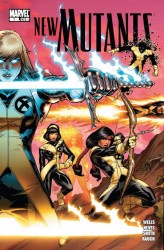 I don’t have history with the New Mutants. I never read their original book, and by the time I’d tried the satellite X-books, they were X-Force. I know a lot of X-Men fans hold the New Mutants in high esteem, but for my money, X-Force was way more interesting. I reread that old X-Force stuff a few months back and didn’t regret it, exactly, but it wasn’t very good, either. The idea of a second generation of X-Men who decided that Xavier’s way wasn’t perfect is a good one, and one that Grant Morrison revisited to great success in New X-Men: Riot at Xavier’s
I don’t have history with the New Mutants. I never read their original book, and by the time I’d tried the satellite X-books, they were X-Force. I know a lot of X-Men fans hold the New Mutants in high esteem, but for my money, X-Force was way more interesting. I reread that old X-Force stuff a few months back and didn’t regret it, exactly, but it wasn’t very good, either. The idea of a second generation of X-Men who decided that Xavier’s way wasn’t perfect is a good one, and one that Grant Morrison revisited to great success in New X-Men: Riot at Xavier’s.
That was years ago at this point, though, and those times are long gone. The members of X-Force have given up, regressed, grown up again, and joined the actual X-Men. New Mutants #1 was written by Zeb Wells, pencilled by Diogenes Neves, inked by Cam Smith and Ed Tadeo, and colored by John Rauch. I checked it out mainly off the strength of Zeb Wells. He wrote the awesome New Warriors: Reality Check, starring Marvel’s other second generation of heroes, which was quickly thrown under the bus by Mark Millar’s Civil War. After reading it, the name New Mutants is basically a nostalgia grab. It stars Sam Guthrie, Roberto Da Costa, Amara Aquilla, Illyana Rasputin, Xi’an Coy Manh, and Dani Moonstar, and I found it a pretty solid first issue.
I’m really only familiar with Sam and Bobby as far as the cast goes, in addition to the surprise villain at the end. Even still, Wells does a pretty good job of selling me on the characters I don’t know, two of whom are blonde females of about the same height. I like that Illyana, who I’d previously seen when she died and maybe in some old X-Men reprints, is back and not exactly a good guy. She’s actually pretty sinister, and not in a “rough edge on a smooth team”-Wolverine sort of way.
The fact that the young students hate her is also a good touch, and a good example of something Wells does that I enjoy. He references a lot of backstory pretty seamlessly, but I never felt like I needed to know exactly what went down in, say, X-Infernus, which was a worthless story with solid art. The references are just used to build history, and to give Wells a bit of short-hand when sketching out the characters for new readers. I feel like Wells gets these characters. Sam and Bobby come across as best friends from jump, and Sam’s loyalty to his friends in particular is very clear. I also didn’t mind the suiting up scene, which usually comes across as corny.
I’m not as keen on the art. John Rauch’s coloring is working in that same style Pete Pantazis has been doing over on JLA– where each character is so brightly light that they look washed out and lightened. To be frank, it’s offputting and ugly. There’s not really any mood to the coloring, other than Outside, In A Basement, and Red Because She Might Be Evil. The color should enhance the art, rather than detract from it. It also sucks that Bobby Da Costa looks about as Brazilian as Bobby Drake.
At the same time, Neves’s art is solid, but unspectacular. He’s pretty solid at drawing kids, though his adults tend to skew a little too much toward the overmuscled superhero stereotype, rather than the early 20s mutants they should be, but that’s just comics as usual. Neves pulls some great facial expressions out of his hat, and though the issue doesn’t have a traditional fight scene, it seems like he’d be perfectly fine at choreographing and staging a solid fight scene.
New Mutants #1 was a solid, if a little unimpressive, read. I’ll give it another issue or so based on my past enjoyment of Zeb Wells and the fact that I like Bobby, Sam, and the surprise villain at the end. For it to be truly good, though, it’s going to need better coloring to even up the art. As-is, it’s a good start, enough to keep me interested, and a pretty decent mid-tier Marvel book. I like seeing these old characters turned into adults, and hopefully it’ll stick this time.

A Serious Post About Serious Issues
May 8th, 2009 Posted by Esther Inglis-ArkellI had a post all set to go for today. You’ll see it tomorrow. Today I would like to take a moment to discuss a very serious illness that I was recently diagnosed with.
It’s called Tie Up The Goddamn Villain Syndrome, and eighty percent of Americans experience it at one time or another. Sadly, mine is an extreme case.
For example, when people around me discuss Pan’s Labyrinth, and how it’s such a breathtaking visual achievement paired with a dark, fairytale-like story, all I can think about is how I wished the murderous bastard of a captain had won, because when that idiot maid incapacitated him temporarily she didn’t Tie Up The Goddamn Villain. For that alone, he deserved to win, and I don’t even care that he knocked a guy’s teeth out with a whiskey bottle.
I have to bite my fist to keep from shouting at screen in every Die Hard movie except the first, because John McClane won’t just Tie Up The Goddamn Villain.
And Dollhouse? The series I started watching out of loyalty to Joss Whedon, and continued watching because it got pretty good, and then got excited about because it got really, really good, just completely tanked in my eyes, because oh my good god, just when the heroine knocked out the villain, and all was won, she wandered off to take care of something else and then acted shocked, shocked!, when it turned out that unconsciousness was a temporary state. And so, I leave you with my final reaction to the series. Read the rest of this entry �
